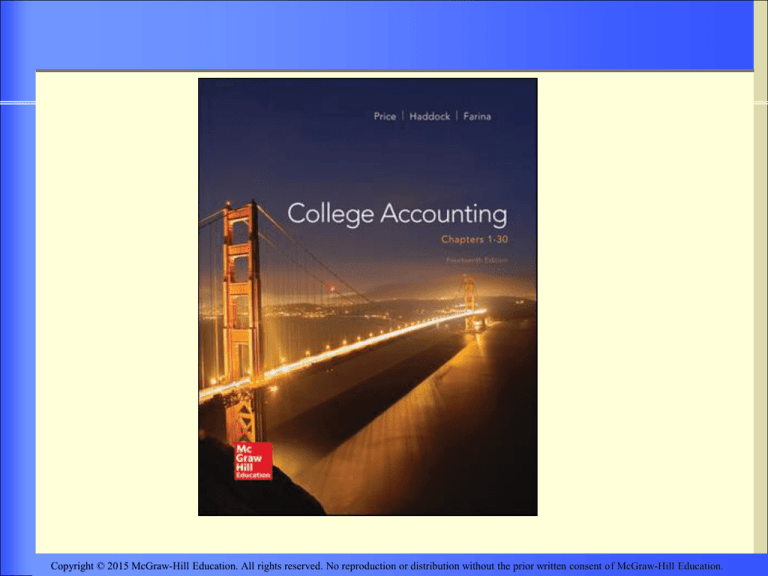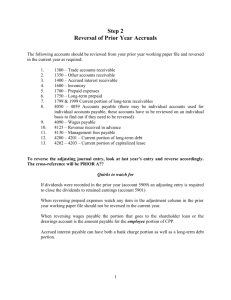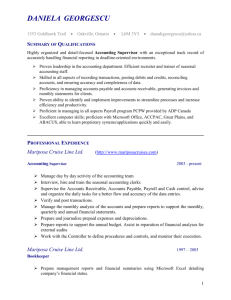
Copyright © 2015 McGraw-Hill Education. All rights reserved. No reproduction or distribution without the prior written consent of McGraw-Hill Education.
Chapter
16
Notes Payable and Notes
Receivable
Section 1: Accounting for
Notes Payable
Section Objectives
16-1 Determine whether an instrument meets all the
requirements of negotiability.
16-2 Calculate the interest on a note.
16-3 Determine the maturity date of a note.
16-4 Record routine notes payable transactions.
16-5 Record discounted notes payable transactions.
Determine whether an instrument meets
Objective 16-1 all the requirements for negotiability.
UCC Requirements for Negotiability
Must be in writing and signed by the maker.
Must contain an unconditional promise to pay a
definite amount of money.
Must be payable either on demand or at a future
time that is fixed or that can be determined.
Must be payable to the order of a specific
person or to the bearer.
Must clearly name or identify the drawee if
addressed to a drawee.
16-3
Objective 16-2
Calculate the interest on a note.
QUESTION:
What is interest?
ANSWER:
Interest is the fee charged for the
use of money.
16-4
Calculating Interest on a note
Interest = Principal x Rate x Time
Amount being borrowed
(also called face value)
Principal x Rate x Time
$4,000
Indicated in fractions
of a year
=
x 0.08 x (90/360) =
Interest
$80
16-5
Calculating the Maturity Date
of a Note.
Principal + Interest =
$4,000
+
$80
=
Maturity Value
$4,080
Determine the number of days remaining in the
month of issue.
Determine the number of days in each full month of
the note.
Determine the number of days in the last month of
the note.
Add the days together to confirm that they equal the
period of the note.
16-6
Record routine notes payable
Objective 16-4
transactions.
Notes Payable Transactions
Record the issuance of a note payable
2016
May. 18
Store Equipment
Notes Payable—Trade
Issued note payable to
Unfinished Furniture, Inc.,
for purchase of store
equipment
4,000.00
4,000.00
16-7
Notes Payable Transactions
Record payment of the note payable and interest:
Interest rate is 8%, term of note is 90 days.
2016
Aug 16 Notes Payable—Trade
Interest Expense
Cash
Payment of May 18
note to Unfinished Furniture, Inc.,
4,000.00
80.00
4,080.00
16-8
Objective 16-5 Record discounted notes payable
transactions.
Discounted Notes Payable
Example: If a $10,000, 6% 60-day note is
discounted with the bank, then the
borrower would receive only $9,900.
Face Amount
–
Discount
=
Proceeds
$10,000
–
$100
=
$9,900
$10,000 x 6% x 60/360 = $100 interest
16-9
Reporting Notes Payable and
Interest Expense
Notes Payable
Current liabilities if due within one year.
Long-term liabilities if due in more than one year.
Interest Expense
Classified as a nonoperating expense.
Listed in the Other Income and Expenses section of
the income statement.
16-10
Chapter
16
Notes Payable and Notes
Receivable
Section 2: Accounting for
Notes Receivable
Section Objectives
16-6 Record routine notes receivable transactions.
16-7 Compute the proceeds from a discounted note receivable,
and record transactions related to discounting of notes
receivable.
16-8 Understand how to use bank drafts and trade acceptances
and how to record transactions related to those
instruments.
16-11
Record routine notes receivable
Objective 16-6
transactions.
QUESTION:
What is a note receivable?
ANSWER:
A note receivable is an asset
representing a written promise by the
debtor to pay the creditor a specified
amount at a specified future date.
16-12
Notes Receivable Transactions
Record the receipt of cash from a customer in
payment of their note:
2016
Aug 11
Cash
Note Receivable
Interest Income
Collection of John Woods’s note
plus
(interest= 1,200 x 10% x 60/360 days)
1,220.00
1,200.00
20.00
16-13
Note Receivable
Not Collected at Maturity
If a note is not paid and not renewed, it is
dishonored.
2016
Aug 11
Accounts Rec./John Woods
Notes Receivable
Interest Income
To charge back Woods’s
dishonored note plus
interest to maturity
1,220.00
1,200.00
20.00
Interest income is recognized and added to
the account receivable
16-14
Objective 16-7
Compute the proceeds from a
discounted note receivable, and
record transactions related to
discounting of notes receivable.
Discounting a Note Receivable
If the noteholder wants cash before the
maturity date, the note can be discounted
(sold) at the bank.
16-15
Discounting a Note Receivable
The bank pays the proceeds to the noteholder.
Principal
+ Interest
– Discount
(Maturity Value)
= Proceeds
16-16
Contingent Liability for a
Discounted Note
QUESTION:
What is a contingent liability?
ANSWER:
A contingent liability is an item that
can become a liability if certain
future events happen.
16-17
Contingent Liability for a
Discounted Note
The note holder endorses the discounted note
receivable.
If the maker of the note dishonors the note, the
bank can obtain payment from the endorser.
The endorser has a contingent liability.
16-18
Reporting Notes Receivable
and Interest Income
Notes Receivable
Current asset if due within one year.
Long-term asset if due in more than one year.
Interest Income
Classified as non-operating income.
Listed in the Other Income and Expenses
section of the income statement.
16-19
Objective 16-8
Understand how to use bank
drafts and trade acceptances
and how to record transactions
related to those instruments.
16-20
Drafts and Acceptances
Draft: a written order that requires one party to pay a
stated sum of money to another party
Check
Bank Draft
A bank orders another bank to pay the stated amount
to a specific party.
It is more readily accepted than a business or personal
check.
Commercial Draft
One party orders another party to pay a specified amount
on a specified date.
It is used for special shipment and collection situations.
16-21
Trade Acceptance: a draft used in recording
transactions involving the sale of goods
Original transaction
Recorded as a sale on
credit
Trade acceptance
Accounted for as a
promissory note
16-22
Internal Control of Notes Payable,
Notes Receivables, and Drafts:
Limit the number of people who can sign notes for
the firm.
Record all notes payable immediately.
Handle drafts as carefully as checks.
Review all past due notes promptly and take
necessary steps, including legal action to insure
payment.
16-23
Thank You
for using
College Accounting, 14th Edition
Price • Haddock • Farina
16-24





